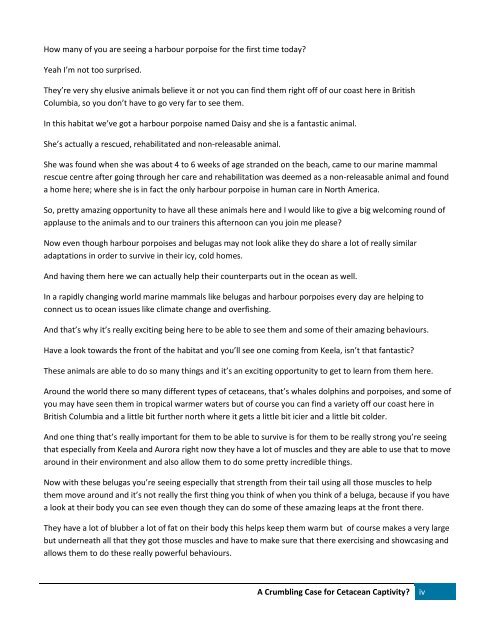A CRUMBLING CASE FOR CETACEAN CAPTIVITY?
MM-Education-and-Conservation-Report-Dec-9-2016-fi
MM-Education-and-Conservation-Report-Dec-9-2016-fi
Create successful ePaper yourself
Turn your PDF publications into a flip-book with our unique Google optimized e-Paper software.
How many of you are seeing a harbour porpoise for the first time today?<br />
Yeah I’m not too surprised.<br />
They’re very shy elusive animals believe it or not you can find them right off of our coast here in British<br />
Columbia, so you don’t have to go very far to see them.<br />
In this habitat we’ve got a harbour porpoise named Daisy and she is a fantastic animal.<br />
She’s actually a rescued, rehabilitated and non-releasable animal.<br />
She was found when she was about 4 to 6 weeks of age stranded on the beach, came to our marine mammal<br />
rescue centre after going through her care and rehabilitation was deemed as a non-releasable animal and found<br />
a home here; where she is in fact the only harbour porpoise in human care in North America.<br />
So, pretty amazing opportunity to have all these animals here and I would like to give a big welcoming round of<br />
applause to the animals and to our trainers this afternoon can you join me please?<br />
Now even though harbour porpoises and belugas may not look alike they do share a lot of really similar<br />
adaptations in order to survive in their icy, cold homes.<br />
And having them here we can actually help their counterparts out in the ocean as well.<br />
In a rapidly changing world marine mammals like belugas and harbour porpoises every day are helping to<br />
connect us to ocean issues like climate change and overfishing.<br />
And that’s why it’s really exciting being here to be able to see them and some of their amazing behaviours.<br />
Have a look towards the front of the habitat and you’ll see one coming from Keela, isn’t that fantastic?<br />
These animals are able to do so many things and it’s an exciting opportunity to get to learn from them here.<br />
Around the world there so many different types of cetaceans, that’s whales dolphins and porpoises, and some of<br />
you may have seen them in tropical warmer waters but of course you can find a variety off our coast here in<br />
British Columbia and a little bit further north where it gets a little bit icier and a little bit colder.<br />
And one thing that’s really important for them to be able to survive is for them to be really strong you’re seeing<br />
that especially from Keela and Aurora right now they have a lot of muscles and they are able to use that to move<br />
around in their environment and also allow them to do some pretty incredible things.<br />
Now with these belugas you’re seeing especially that strength from their tail using all those muscles to help<br />
them move around and it’s not really the first thing you think of when you think of a beluga, because if you have<br />
a look at their body you can see even though they can do some of these amazing leaps at the front there.<br />
They have a lot of blubber a lot of fat on their body this helps keep them warm but of course makes a very large<br />
but underneath all that they got those muscles and have to make sure that there exercising and showcasing and<br />
allows them to do these really powerful behaviours.<br />
A Crumbling Case for Cetacean Captivity?<br />
iv


